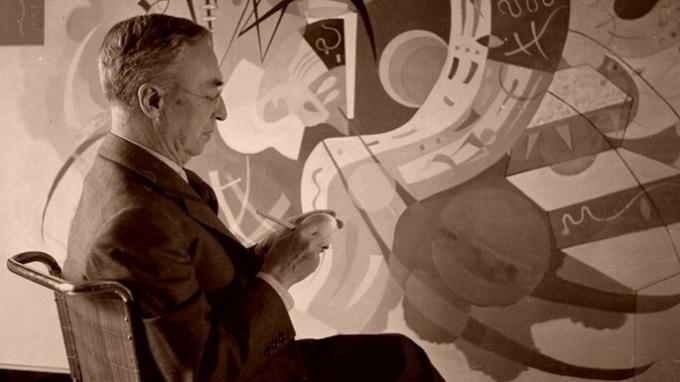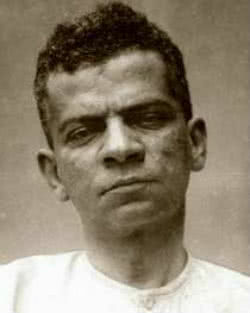Wassily Kandinsky (1866-1944) was a prominent Russian artist in the early 20th century.
Considered a pioneer in the abstractionist movement, the painter brought innovation to the world of arts, being an indispensable name in European modernism.
In addition to being an artist, Kandinsky was also a theorist and art teacher, bringing important contributions about the theory of colors, the synaesthetic relationships between music and plastic arts and on compositions non-figurative.
Kandinsky Biography
Wassily Kandinsky was born on December 4, 1866, in Moscow, Russia.

His family belonged to the Russian high bourgeoisie, his father being a wealthy tea merchant. Around the age of 5, after moving to Odessa, Ukraine, his parents separated. The boy is then raised by his aunt, Elizaveta Ticheeva.
His aunt becomes an important reference for Wassily, transmitting spiritual values, encouraging him in musical education and transferring knowledge about Russian legends and traditions.
Wassily's childhood was in the midst of drawing lessons and, mainly, music. He learned to play the piano and cello, and was later enrolled at the Humanist Institute in Odessa.
In 1886, at the age of 20, he entered the Law and Political Economy course at Moscow University. There he actively participates in political mobilizations against tsarism.
Later, Kandinsky visits the Hermitage Museum in St. Petersburg and is impressed by the painting by Rembrandt (1606-1669).
Some time later, in 1889, he went for the first time to Paris, where the seed of modern art was beginning to germinate.
Wassily marries his cousin Anya Chimiakin in 1892. The following year, he defends his doctoral thesis with the theme About the legality of salaries, in which he discussed the living conditions of the working class.
Kandinsky decides to be an artist
Wassily's life was professionally stabilized. He held a position at the university and worked at a publishing house as an artistic director.
Until, in 1896, an important exhibition of Impressionist painting was inaugurated in Moscow. In this exhibition, Kandinsky had contact with the works of Monet (1840-1926) and was really impacted, especially with a series that featured haystacks.
In his 30s, Wassily makes a decision that would change his life forever. He denies a job offer as a professor at the University of Dorpat and decides to abandon his jurisprudence career in order to devote himself to art.
He then moves to Germany and takes classes at Anton Azbè's studio. Thus, he is enchanted by outdoor landscape painting, while he has an antipathy to the practice of drawing a living model.
Kandinsky becomes close to other painters and starts his experiments in painting, abusing shapes and colors. In 1901 he helped found the artists' association Die Phalanx (A Falange), who questioned traditional art and proposed new ways of creation.
In 1904, Kandinsky meets Gabriele Münter, who would later become his second wife.
Kandinsky's abstraction
Wassily is inspired by the profusion of colors proposed by fauvism and begins to relativize figurative representation.
His partner, Gabriele Münter, was an expressionist artist and introduces him to the technique of painting on glass, in addition to contributing with important reflections on art.
Around 1910 and 1911, the painter produced his first canvases called Improvisations. It was during this period that the artist became acquainted with the music of Arnold Schönberg, who would influence him to study the effects of music combined with painting.

Kandinsky joins up with other artists in 1911 and together they form the expressionist group Der Blaue Reiter (The Blue Knight).
Besides him, the participants were Alexej von Jawlensky, Franz Marc, August Macke, Paul Klee and Marianne von Werefkin.

In 1912, he published a book on color theory and its psychological influence, entitled "Do spiritual na arte", a work that made an impact in the artistic universe.
Kandinsky was a lover of metaphysical theories and used the interactions between music and the visual arts as a creative tool. It could be said that he was a mystic who believed in transformation through an innovative art that brought "inner" values.
About the creative process, he once stated:
Painting is a thunderous clash of opposing worlds predestined to create together, in the struggle and from it, a new world called work.
In 1914, due to the tense political situation that preceded the first war (1914-1918), Kandinsky and Gabriele move to Switzerland. Shortly thereafter, the couple break up.
It was during the time he was married to Gabriele that the painter took a creative leap in his production and established himself as an avant-garde artist.
From that moment on, Kandinsky took up residence in Moscow and went through a creative crisis. In 1916 he meets Nina von Andreevsky and the following year, he marries at 51 years of age the young woman 23 years his junior.
Due to the end of the tsarist government and the implantation of the soviets,or workers' councils, which took place in Russia in 1917, there was a great artistic effervescence. Art at that time gained notoriety and artists had freedom to create. Later that year, the painter's only son, Vsevolod, was born.
In 1918, Kandinsky took up the teaching of the State Art Laboratories. From then on, he became involved in the country's public policies and helped to implement several museums in Russia between 1919 and 1921.
Later, in 1922, the artist had his work exhibited at the 1st Exhibition of Soviet Art in Berlin.
Kandinsky's years at the Bauhaus
Also in 1922, Wassily Kandinksy was invited to join the teaching staff of the Bauhaus School, founded in 1919 by Walter Groupius, in Germany.

Teaching painting classes, the artist felt again at ease to resume painting in his life, which had been left aside during the years he worked for the State.
Bauhaus was a school of architecture, design and the arts whose teachers were several important artists, such as László Moholy-Nagy, Paul Klee, Marcel Breuer and Marianne Brandt.
Together with his colleague and artist Paul Klee, he prepares the essay Point and line on plane, that discussed abstractionism and related it to musical creation.
In 1925, due to instability and political pressures, the Bauhaus moved from Weimar to Dessau.
The institution experienced years of intense artistic experimentation, which would come to influence all Western art. Unfortunately, in 1933 the Nazism starts to grow in Germany and one of the first initiatives of adolf hitler went to pursue the art and activities of the school, which closed in July of that year.
Kandinsky's last years in Paris
Due to the hostile atmosphere in Germany, Kandinsky and his wife decide to live in Paris, France.
There, the artist comes across big names in modern art, such as miro, Léger, Mondrian, Hans Arp and Sonia Delaunay, also getting involved with the Abstraction-Creation group, in London and New York.

In Germany, his art continues to be persecuted and he has his works confiscated by the Nazi government.
Wassily continued to produce and produced six individual shows. His last screen of greatest importance was reciprocal waking, made in 1942.
The artist died at the age of 78, on December 13, 1944, victim of a stroke. Years later, his wife organizes an exhibition with more than 2,000 unpublished works by her husband.
Important works by Kandinsky
We selected important works by this artist, displayed in chronological order.
1. The Blue Knight (1903)

2. Canto do Voga (1906)
3. Improvisation VI (1909)

4. Improvisation IV or Battle (1911)

5. Cloudy (1917)

6. White Cross (1922)

7. Over White II (1923)

8. Yellow, Red, Blue (1925)

9. Movement I (1935)

10. Sky Blue (1940)

Don't stop here! Continue your studies with related texts:
- Abstract Expressionism
- Jackson Pollock: life and work
Bibliographic references
Folha Collection - Great Masters of Painting
The history of art - E.H. Gombrich




